Fellow potters and visionary art lovers who have been privileged to meet Mary Bowron are as passionate about her as she is about her work. Those who have visited her studio and seen her art tend to concur with her youngest daughter Ellen who has stated unequivocally that her mother is a genius.
The 84-year-old self-taught potter was born and raised in the South, but lived most of her adult life on a 91-acre farm in Boyds. Sadly, due to declining health, Bowron has moved to California to live with her family and cannot be interviewed. By excerpting the brief biography she and her daughter wrote together and eliciting the insights of individuals who know her and her work, a clearer picture of the octogenarian artist whose work will be part of an exhibit at a museum dedicated to visionary art will emerge.
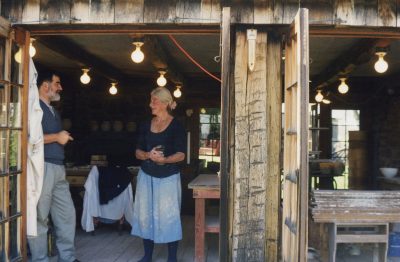
The bio said that Mary Bowron: “has been working with clay consistently since the early 1960s when she lived in southern California. She tried pottery as a young mother seeking an outlet for her creativity. She set her wheel to work in the dining room of her house, firing her wares at the Pot Shop in Venice Beach.
“Her journey has led her from all manner of functional wheel-thrown tableware–vases, lamps, bowls, teapots, tea bowls and plates–to innovative methods of slab-formed vessels, tile-making, sculpture of birds and horses, sculpture depicting clustered human forms, through to her decades-long creation of the ‘Silent Witness’ heads. Her kilns have been gas-fired, wood-fired anagama and pit-fired.
“Her natural curiosity and inclination toward experimentation leads Mary to any medium that might produce the effects she sees in her mind’s eye, where nothing is off limits. Whether clay, paint, paper or bronze, copper-plate etching, wax, mono-prints, photography or even the natural environment, Mary feels compelled to create. She would tell you that she will never have enough time to bring all her ideas to life; she will never run out of things to say.
“You must not always choose, ‘pretty.’” Mary’s work frequently depicts humans and animals in both their most glorious form and their most vulnerable and wounded.
“She is a compulsive information gatherer, collecting a deep library of books, never failing to stop and meet an artist, never fearing a failed experiment and having a singular focus on her processes. From these and a universe of dreams, ideas, experiments and experiences, Mary creates.”
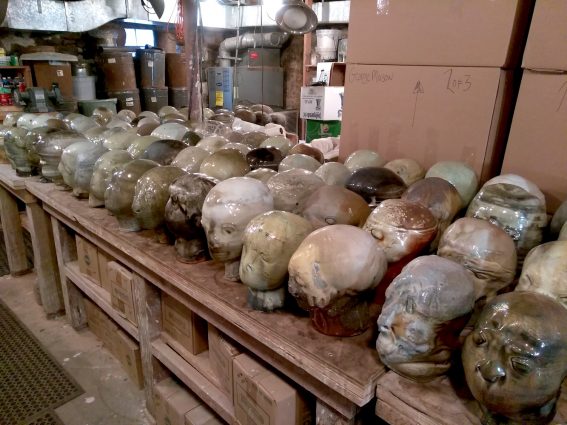
Chad Buterbaugh, who directs the Maryland State Arts Council’s Maryland Traditions program, learned about Bowron from ceramic artist Anthony Stellaccio, who invited him to see her studio, her 50-foot kiln and her “massive collection of pottery,” meet her longtime collaborator and assistant Robert Kelly, and assess “whether Mary would be a good fit for Maryland Traditions, which supports folk and traditional artists who have learned their work by word of mouth or example.”
Kelly, noted Buterbaugh, “(who) mixed the clay she used, built the spectacular kiln and oversaw the firing process, which takes 10 to 12 days of round-the-clock work” is seeking “some recognition for the work he and Mary have done together … It breaks his heart to know that the kiln is currently full of unfired material that might literally go to pieces. He feels frustrated, too, because he had a crew ready to fire this last batch–hand-picked from potters working up and down the East Coast–but could not acquire the compensation to get the job done, even at reduced rates.”
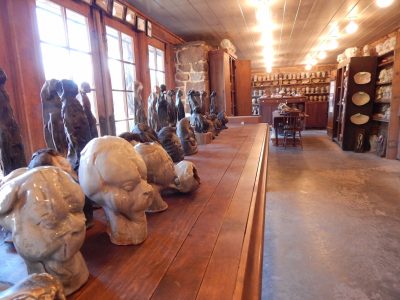
Buterbaugh found that Bowron’s “otherworldly clay creations…fit more comfortably in the realm of visionary art, or that style of art in which the artist creates a brand-new form of aesthetic expression based on her own unique vision, which often does not fit within established artistic guidelines.” Still, he was “so intrigued by her work, and so compelled by her story that I alerted folks who might share her story with the public.” Hence, this CultureSpotMC story on behalf of the Arts and Humanities Council of Montgomery County, where Bowron produced so much of her work.
Stellaccio met Bowron in 1998 when he was an intern for ceramic artist Patrick Caughy at the Maryland Institute College of Art. “It was exactly what I needed as a kid in art school,” he recalled. “I took a lot of cues and inspiration from (meeting) an outsider, self-taught artist (who) was not in a formal academic institution yet became a major cultural icon. You know genius when you see it.” Like Stellaccio’s own mother, he said, “Mary is stubborn and very independent, strong willed.” He considers her a role model, an inspiration and a kindred spirit who he appreciates most for not being “a slave to the market, the art world, (instead) always doing what she loved to do.”
Recently, Stellaccio gathered some 25 pieces of Bowron’s unclaimed work, “a good variety, most from the last few years and some earlier, including about eight heads, a small wall-mounted mask, a horse, pots and bowls” for the Baltimore Clayworks exhibit he is planning for the summer of 2018.
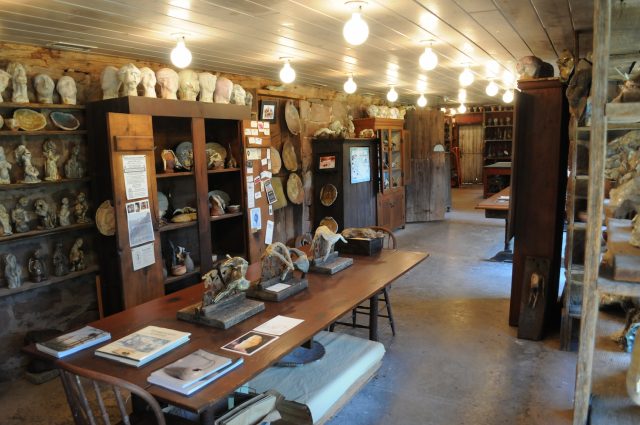
Caughy, a Clayworks associate artist, connected with Bowron, whom he described as “unlike anyone else,” through Joyce Michaud, director of Hood College’s ceramics program. He helped with Bowron’s first wood kiln firing in Boyds, circa 1998, as well as subsequent ones. Caughy noted that clay artist Cynthia Bringle called her old friend and fellow Southerner “the most creative person I’ve ever known.”
Bowron, said Caughy, was “solitary, but far from isolated. She drew from underground streams of culture–her home was filled with remarkable books on pottery, history, poetry, sociology and psychology, and NPR’s news of the world infused her work with issues of justice, the quality of education.” And the little altar-like displays around her house had no Wedgewood or Pottery Barn items; rather, they offer “a sense of tremendous reverence.” The “wonderful rustic appeal” of her work indicates her “great respect for the earth.”
For Bowron, Caughy said, “every day is the first day of school,” citing her exuberance, innocence, tremendous generosity of spirit and empathy that “give her work its power.” Of her series of heads with no mouths and her figurative bronzes (which, he said, some say belong in the Holocaust Museum), he noted, “she was well aware that her work could startle visitors.”
Rick Malmgren, potter and professor and ceramics coordinator at Anne Arundel Community College, has known Bowron since 1965 because of her 50-plus year friendship with his mother, potter Ebby Malmgren. “When I became a full-time potter in the mid-1970s, I was deeply inspired by Mary’s functional pottery and the way that she handled clay in such a fluid way with such elegant brushwork,” he said. Her “big way” of doing things was remarkable. “When she made slab plates or sculpture, her series went into the hundreds of pieces. Similarly, her wood kiln was built to involve not only friends, but an entire community of potters. She has been inspiring in the way that she thinks and acts so expansively and inclusively.”
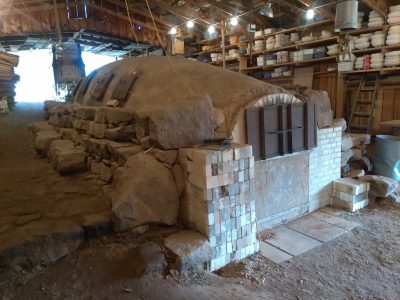
About eight years ago, while riding his bike, PostSecret Project blogger Frank Warren noticed some ceramic work on a railcar parked near the rural road where Bowron lived. Proceeding up the driveway he “discovered a hidden compound behind the trees.” He pulled the cord of an overhead bell, which “rang loud throughout the countryside. Mary came out from her work studio.” Their subsequent friendship included tours of her kiln and foreign films in her movie room.
“Mary is a singular person and artist and represents Montgomery County well,” Warren said. “She consistently said ‘no’ to developers who wanted to buy her valuable and large rural property, but ‘yes’ to anyone who wanted to learn her patient, experimental, visionary ceramic techniques.”
Warren, too, was most “drawn to the scores of ceramic heads she had created over the years–each like a silent sentry, but no two identical. I had never seen anything like it,” he recalled. But “beyond her work, Mary’s wit was her specialty,” he added. “With her age, she had earned the right to see the world, share her ideas and disagree with others in a way that was refreshing and inspiring.”
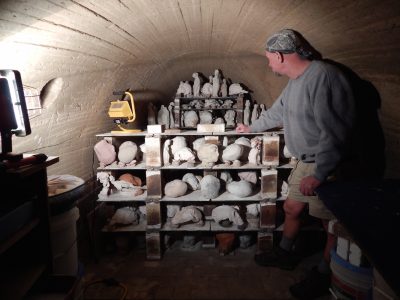
Bowron called Terri Yoho, the executive director of the Wisconsin-based Kohler Foundation Inc., on Jan. 6, 2015. Bowron offered Kohler, which since the 1970s, has supported the preservation of collections by self-taught artists, her personal collection of 600 heads.
After seeing the work, each about 10 inches tall, Yoho said, “Mary’s art tells a compelling story and she is an amazing artist. The work is beautifully crafted and uses a wide range of technique and glazes, certainly many experimental. What really captured our attention was the variety, number and beauty of the heads (and) the fact that Mary was mostly self-taught.”
According to the Kohler website, Bowron described the heads: “All have no mouth for fear of speaking what they say and hear. This fear is a plague on us all.” Yoho added that “not being able to talk about the true issues, and being aware of this even as a child is quite remarkable, and so few women have built environments like this. Mary’s passion for human rights is profound.”
During two visits to Boyds, Yoho brought “museum folks in to see her art.” When Bowron learned “they had made selections for their permanent collections, her eyes literally danced with happiness. I believe if she had been able to jump out of bed, she would have!
Bowron’s joy was “palpable,” said Yoho. “It was amazing to spend time with Mary and witness her dream coming true. This is what she had worked so hard for, over so many years. Never for financial gain or recognition, simply to create and to share her message.”
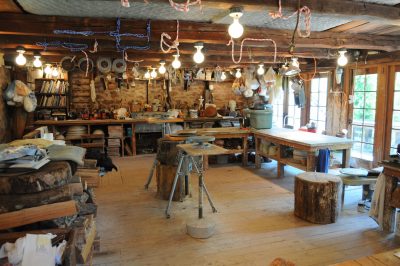
Thus far, Yoho said, “The John Michael Kohler Arts Center took a large collection (162 pieces), taken right from Mary’s studio area, to “capture” the essence of how she displayed the work, how she created an art environment with her heads and other art pieces.” Among the local groups that received pieces are Baltimore’s American Visionary Art Museum (41 pieces), the Washington County (Maryland) Museum of Fine Art (12) and Virginia’s George Mason University (11).
Frank Warren introduced the American Visionary Art Museum founder and director Rebecca Hoffberger to Bowron. The museum, Hoffberger said, looks for “work infused with an original and personal vision, born of innate intuition and passion,” and Bowron’s heads fit the bill.
Bowron, she said, is “a true visionary, as evidenced in all her ways–from her farm with its alley of cherished Paulownia trees (the sacred tree of the Far East) to her fierce hands-on involvement with bush hogging her own fields, with long white hair flying, and her decades of sensuous hand-formed clay heads and hand-firing pits.”
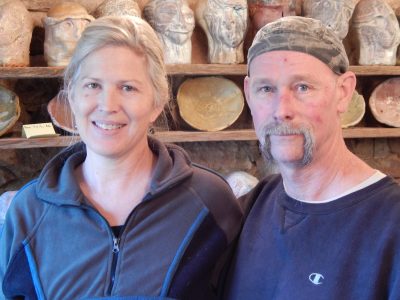
Bowron’s heads will be featured in “The Mystery of The Missing and the Silenced” section of the museum’s “The Great Mystery Show,” that will open Oct. 7 and run through Labor Day, 2018, and Hoffberger is delighted. “Mary is that one-of-a-kind radiance one encounters, if really lucky, but a handful of times in a long lifetime. She has a great laugh. Mary’s focus on mouth-less heads expresses her sincere tribute to humanity’s voiceless, abused, missing, country-less, millions.”
Ellen Bowron said that “making my mother happy is the most satisfying thing in the world. There’s nothing like the feeling of her approval, getting it right.” Hopefully, all these voices did.